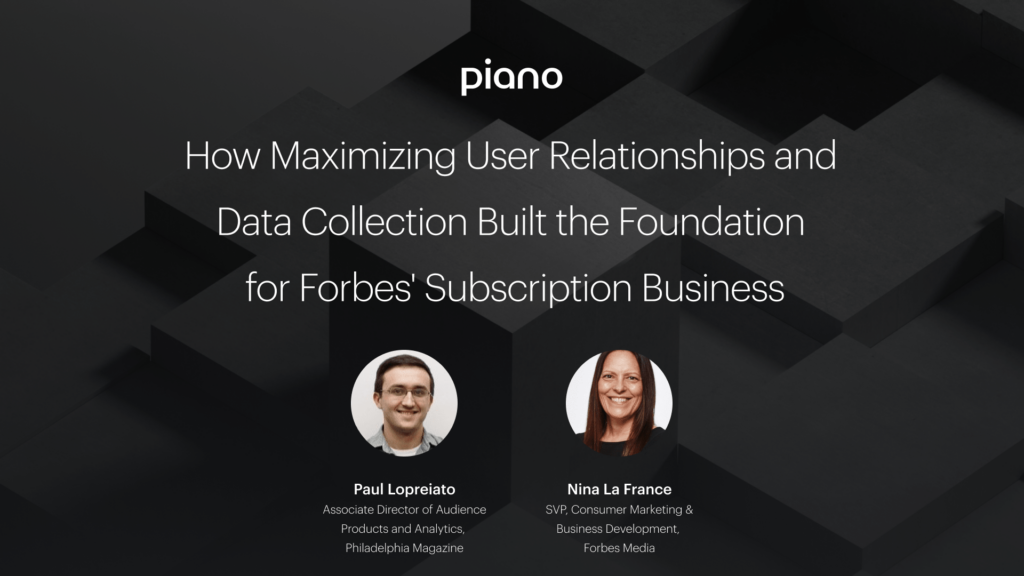How Philly and Boston Magazines Pivoted to a Reader Revenue Model
In the recent Piano Academy session, “How Local and National Publications are Transforming Their Businesses Through Reader Revenue,” we compared how local publications Philadelphia and Boston Magazines and national publication Forbes launched their subscription models. In this post, we deep-dive into Philadelphia Magazine’s approach with Paul Lopreiato, Associate Director of Audience Products and Analytics.
Leading historic publications into a new digital era
Boston Magazine is a 216-year-old publication — Philadelphia Magazine 113. In terms of digital experience, both were following the same track in the time preceding their reader revenue programs, Lopreiato said. The publications, which both have small editorial teams, had been selling ad revenue and offering several newsletters between them, but not directly asking users to pay for content. In late 2019, Lopreiato’s team began working with the wider Philadelphia Magazine organization to build the process for launching a paywall in July of 2020 (Boston Magazine’s just launched on February 23rd).
“So what that means is we're speaking with our sales teams to make sure that they understood what a paywall meant, because the first thing we ran into is almost everybody has a different definition of paywall,” Lopreiato said. “Some people think it means readers only, some people understand the meter model. Some people think everybody's going to be metered.”
Lopreiato’s team aimed for about 8 percent of its audience to be metered every month, with a paywall shown on the fifth article. They worked with the Philadelphia-based Lenfest Institute for Journalism, whom they consulted about different metrics like conversion rate and how many people they should expect to hit the paywall.
With the summer 2020 launch date identified, preparation started before COVID. Once the pandemic did hit, Philadelphia Magazine’s traffic went haywire like many other news publications’ did. It made it clear that there really was no perfect time to begin the paywall.
“Things were changing,” Lopreiato said. “We didn't know what the world was gonna look like a month away, six months away...for us a paywall had to be a strategic decision. There wasn't one thing that we would just turn on and say, now is the perfect time for a paywall.”
Metrics that matter in the lead-up to launch
A tiny team took on the details of the pre-launch plan — Lopreiato, his manager, two developers and one other person chipping in part-time. They also made sure to work in concert with both their editorial team, with whom they met weekly, and the sales team to share performance data and help them build an audience for the paywall. That way, when they did turn on the paywall, they would have as many people hitting it as possible. They picked a main metric rooted in actionable data — users who returned five or more times a month — so they could track through Google Analytics how many people would actually hit this paywall, which was their biggest concern.
“Although it wasn't a perfect metric, we could get the general idea of what was doing really well with that audience that was going to hit the paywall,” Lopreiato said. “And we knew directionally what the general universe of people who might be and what they're going to read.”
When it came to pricing strategy, Lopreiato’s team set a monthly subscription rate of $4.99 and annual for $49.99. The Piano team suggested a decoy offer for two years at $80 — and that ended up being what most people bought on launch. They then ran monthly tests, trialing a price $1 higher and $1 lower. The lower price didn't increase conversions to make it worth it revenue-wise.
Aligning editorial products with consumer revenue
Launch day was exciting — and also a little sad. There wasn’t a huge rush of people to the paywall. Another surprise the week of launch: the focus was on getting current print subscribers signed up online. More subscribers came over time as the publication built more stops.
“So far, only about 4% of our new purchases occurred within that first week, which means like 95% of purchases have happened since then, right?” Lopreiato said. “It's the beginning of a long journey. And we have to convince people to hit the paywall, let them know we have a product and convince them to buy that way.”
Lopreiato and his team noticed that there weren't enough purchases on every written piece, and that the metric wasn't controllable by their writers. They decided to move one step higher up the funnel. And after a few months, they started to see, via Piano’s reporting, the site-wide conversion rate back into a number of stops needed from their writers every month. The editorial team is now more focused on writing for pageviews.
“We took the average amount of pieces per month and then set a target of stops for every piece,” Lopreiato said. “And then that's sort of where we are now with our editorial team. They know exactly how many stops each piece gets. They don't worry about making sales on the pieces. That's my team's side. We focus on sort of taking all those people who've stopped and then bring them into becoming purchasers.”
Other strategy shifts included changing up the focus on referral sources and rethinking primary metrics. With Facebook’s algorithm gone haywire in the leadup to the US presidential election, Philadelphia Magazine’s site traffic got crushed. So they renewed their focus on emails and sources they could control moving forward. Lopreiato’s team also focuses more on conversions now and less on getting people to stop. They look at analyses of their performance daily, and are currently testing non-meter paths like making certain pieces of content Subscribers-Only. They’ve been testing locking down articles altogether, which has brought in a large number of subscribers. They’ve also tested click-bait articles that, unsurprisingly, didn’t bring in many subscribers.
“The big lesson for all of us is now that we've aligned our editorial products with consumer revenue, we can make the case for more investment,” Lopreiato said. “And we've been doing that. And I think that's the thing I'm most proud of so far, is we're no longer beholden to sort of seeing what the sales team can sell in terms of pageviews. We know we need this many, we can bring in this much revenue. Through this many conversions. We know how to get to conversions through stops, we know how to work with our editorial team to bring in more of those stops. And then they get put in control of sort of where we go moving forward. And we can make the case for more writers and which we've, we've been doing.”




